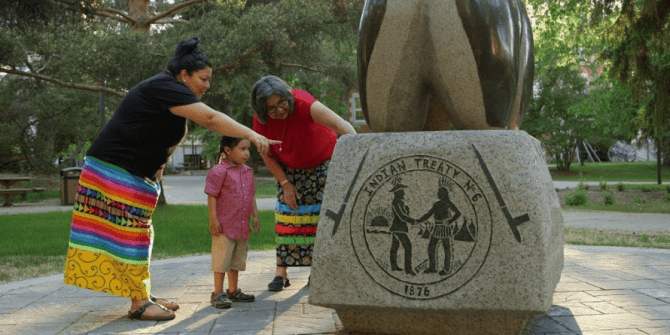August 23 marks an important occasion for Edmontonians as it is Treaty No. 6 Recognition Day. Edmonton became part of Treaty No. 6 Territory on Aug. 23, 1876, but many of the First Nations in the area adhered to Treaty No. 6 at Fort Edmonton on Aug. 21, 1877. This day holds significant importance as it marks a historic agreement between Indigenous nations and the British Crown. It serves as a reminder of the enduring relationships between Indigenous peoples and settlers, fostering unity and understanding for future generations. In this blog, we delve into the history, significance, and relevance of Treaty No. 6, shedding light on its lasting impact on all those who live in Treaty No. 6 Territory today.
What are Treaties?
Treaties are formal agreements between sovereign nations, historically made to establish peaceful relationships, define territories, and provide frameworks for mutual cooperation. In the context of Canada, many of the treaties within Canada were first negotiated between Indigenous Nations and the British Crown. These agreements were foundational in shaping the nation’s history, yet their importance often gets overlooked. From the Indigenous perspective, treaties are a kinship-creation exercise.
By recognizing Treaty No. 6, we honour the commitment and spirit of collaboration that guided these negotiations.
The History of Treaty No. 6:
Treaty No. 6, initially signed on Aug. 23, 1876, was a pivotal moment in the history of the prairies. The treaty was negotiated between the British Crown and representatives of various Indigenous nations, including the Plains and Woods Cree, Nakota Sioux, Dene, Saulteaux and others. The treaty signing took place at Fort Carlton, near present-day Prince Albert, Saskatchewan.
Through this treaty, the Indigenous signatories agreed to share their lands and resources (above the depth of a plow) with settlers in exchange for various provisions, including reserved lands, education, healthcare, and ongoing annuities. Non-Indigenous peoples were guaranteed the right to political self-determination, religious freedom and economic prosperity. It was envisioned to foster peaceful coexistence, but the interpretation and implementation of the treaty's terms have been a source of contention over the years.
The Importance of Treaty No. 6:
Treaty No. 6 holds immense importance for both Indigenous communities and Canada as a whole. For Indigenous peoples, it symbolizes a commitment to their ancestral lands, cultures, and ways of life. The treaty reaffirmed the rights and traditions of the signatory nations, preserving their connection to the land and their ability to sustain their communities.
For Canada, Treaty No. 6 represents a critical acknowledgment of the nation's ongoing responsibility and relationship with Indigenous peoples. Recognizing this day fosters reconciliation and demonstrates a shared commitment to building a future based on mutual respect and understanding.
The Enduring Relevance Today:
More than a century after the signing of Treaty No. 6, its relevance and impact continue to resonate in modern society. Acknowledging this day is an opportunity to:
- Honor Indigenous Heritage: Treaty No. 6 Recognition Day allows us to celebrate and honor the diverse cultures, languages, and traditions of Indigenous peoples who have been stewards of these lands for millennia.
- Promote Reconciliation: By recognizing the historical significance of treaties, we take a crucial step towards reconciliation, acknowledging the past injustices and working towards a more inclusive future.
- Strengthen Community Relations: Observing Treaty No. 6 Recognition Day provides a platform to foster dialogue, understanding, and collaboration between Indigenous communities and the wider Canadian population.
- Promote Indigenous Literature and Knowledge: To deepen our understanding of Indigenous perspectives and our shared history, you can explore these booklists - for kids: As Long as the Sun Shines: 11 Books for Kids about Treaty & Kinship | Edmonton Public Library | BiblioCommons and adults: Commemorating the 148th Anniversary of Treaty 6 | Edmonton Public Library | BiblioCommons.They feature a selection of books that shed light on the rich heritage and treaty kinship of Indigenous peoples.
- Learn the Land Acknowledgement Rhyme: For kids and learners of all ages, Amiskwacîwâskahikan Land Acknowledgement Rhyme is a wonderful resource to recognize Treaty No. 6 and the importance of understanding the traditional territories of Indigenous communities.
By understanding the history and importance of Treaty No. 6, we lay the foundation for building respectful and inclusive relationships in our diverse society. Let us embrace Treaty No. 6 Recognition Day as a chance to learn, grow, and stand together in kinship with Indigenous peoples, honoring their past, present and future.
Visit your local branch between August 18 to 24 to learn more about Treaty No. 6.
More Resources
- Treaty Walk: A Journey for Common Ground, opens a new window
- Confederacy of Treaty 6 First Nations Website, opens a new window
- Confederacy of Treaty 6 First Nations Fact Sheet
- How to be a Better Treaty Person, opens a new window
- Treaty 6 Resource Worksheet (Alberta Teachers’ Association), opens a new window
- Alberta Map of Treaties & Regional Zones of the Métis Nation of Alberta, opens a new window
- Treaty 6 Research Report, opens a new window
- City of Edmonton Indigenous Framework, opens a new window



Add a comment to: Treaty No. 6 Recognition Day